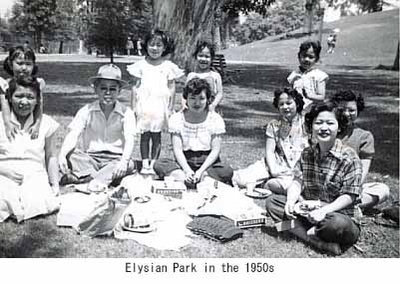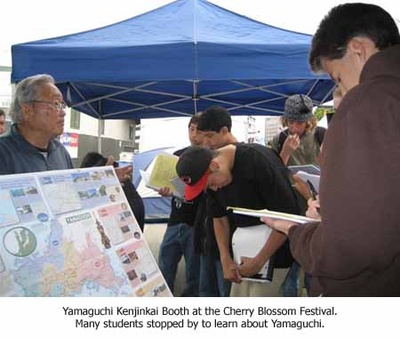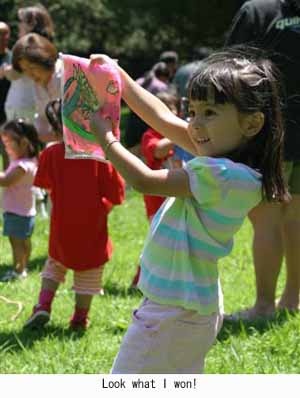I had my eye on the prize…a cute white wicker purse with bright red plastic cherries decorating the top. So, on that summer afternoon over 50 years ago, I coaxed my mom into running the 3-legged race with me at the Yamaguchi Kenjinkai Picnic.
My Nisei parents, along with our extended family and many friends, always planned early for this annual outing. My mom would make the sushi (both futomaki and inari) and the macaroni salad. Auntie Mary would make the chow mein. Yamane-san would make the onishime. And so it went down the line with every adult member of the group contributing some tasty dish to our obento on that one special summer afternoon. It was a feast to behold! This annual event, with delicious food and fun-filled games, was not only a wonderful opportunity for our family to spend quality time together, but for us to spend quality time with our entire “kenjinkai family.” Though I didn’t realize it at the time, the picnic was the seed that began my involvement in the Yamaguchi Kenjinkai.
As an adult, I became a Yamaguchi Kenjinkai board member quite by accident. My husband was asked to become district representative of the San Fernando Valley. But, at his first meeting, he realized everything was discussed in Japanese. Since he didn’t speak Japanese, he delegated the job to me, and I have attended the meetings in various capacities ever since.
Through my affiliation with the Yamaguchi Kenjinkai, I became aware of many more cultural activities and opportunities. One such opportunity came in 2001, when our kenjinkai took a trip to Japan. The purpose of the trip was to attend the Kirara Expo in Yamaguchi. In all, 9 members of my family joined in the experience. It was a wonderful way for me to get in touch with my roots and to share experiences with other Yamaguchi Kenjinkai members and their families. A highlight of the tour was a visit with the governor of Yamaguchi Prefecture. Governor Sekinari Nii welcomed us into his office and expressed his pleasure at how active our organization was in Southern California. This meeting was actually televised on the Japanese news.
After the organized portion of our tour ended, we extended our stay for a few days to visit with four of my mom’s sisters, and visited the place where my mother grew up. Though the house is now remodeled, the land, the rice fields and the stream are still as my mother remembered. We have very fond memories of that trip. With the wonders of e-mail, I now correspond with one of my aunts in Japan on a regular basis, thus bringing me closer to my roots.
In 2005, I became actively involved in another project, along with a committee of Yamaguchi Kenjinkai members. The project’s goal was a huge one … creating our organization’s 100th Yearbook. Like the ancestors of many other kenjinkai, our Issei grandparents immigrated to the United States at the turn of the century, arriving in 1905 in search of a better life. With no support system in the United States, they depended solely on others who had immigrated from Yamaguchi, bonding together to form a group, which was the start of the Yamaguchi Kenjinkai. At that time, it was truly an organization based on necessity. Members helped each other in any way they could, whether it meant providing information, money, or friendship. Of prime importance was the social interaction … sharing stories, songs, and news from home, and in the language they understood, was their salvation.
In the two years it took to complete the 100th Yearbook, I learned so much about my heritage, including the history of the Yamaguchi in Japan, and the history of the Yamaguchi Kenjinkai in Southern California. During the weekly meetings with the other committee members, a strong bond developed among us. We were a group that spanned two generations, but truly appreciated the strengths of each of our members. This was reflected in the completion of a beautiful book.
In an effort to include the Sansei, Yonsei and Gosei generations, it is important for the kenjinkai membership to remember that though change is difficult, it is also very necessary. The kenjinkai should be commended for taking a giant step toward change by switching to the use of English-only at all meetings and functions. Although it is no longer the kenjinkai of 100 years ago, which was formed out of necessity, the kenjinkai now serves as a bridge between the past and future, which is a very important function, nonetheless. We must engage the interest of younger generations by offering ways in which they can learn about their roots through our history, knowledge and experience. Hopefully, this will translate into a more meaningful kenjinkai that will instill pride and tradition in those generations to follow. This journey that paved my involvement with the kenjinkai has now grown into a commitment … a commitment to keep the kenjinkai as pertinent and meaningful to a brand new generation, as it was in the past.
Footnote: At that picnic 50 years ago, my mother and I raced to the finish line, winning first place in the three-legged race. I could not contain my glee as I walked away with that much sought after white wicker purse with the plastic cherries on top. Today, though she doesn’t run any races, my 92-year-old mother still attends our annual picnics. So now, as the incoming president of Nanka Yamaguchi Kenjinkai, not only do the board members and I strive to make the annual picnic as much fun for everyone today as it was 50 years ago, we also strive to include additional activities that will interest the future generations. Hopefully, we can plant those seeds of involvement in the younger generation so that our legacy will be carried on well into the future.
* * *
Discover Nikkei presents....
Kenjinkai: Past, Present, and Future
Join members from four local Kenjinkai groups (Hiroken, Kagoshima Heritage Club, Mie Kenjinkai, Yamaguchi Kenjinkai) for a presentation and discussion moderated by Professor Lane R. Hirabayashi exploring what the Kenjinkai mean to younger generations and what needs to change in order for these associations to continue to exist in the future.
Japanese American National Museum
Saturday, March 28, 2009
2–4 PM
Light reception to follow
RSVP required to 213.625.0414 ext. 2227 or rsvp@janm.org (Subject: Kenjinkai, March 28).
**Please indicate the names of all guests attending.
Click here for more information >>
* * *
© 2009 Arlene Nakamura





